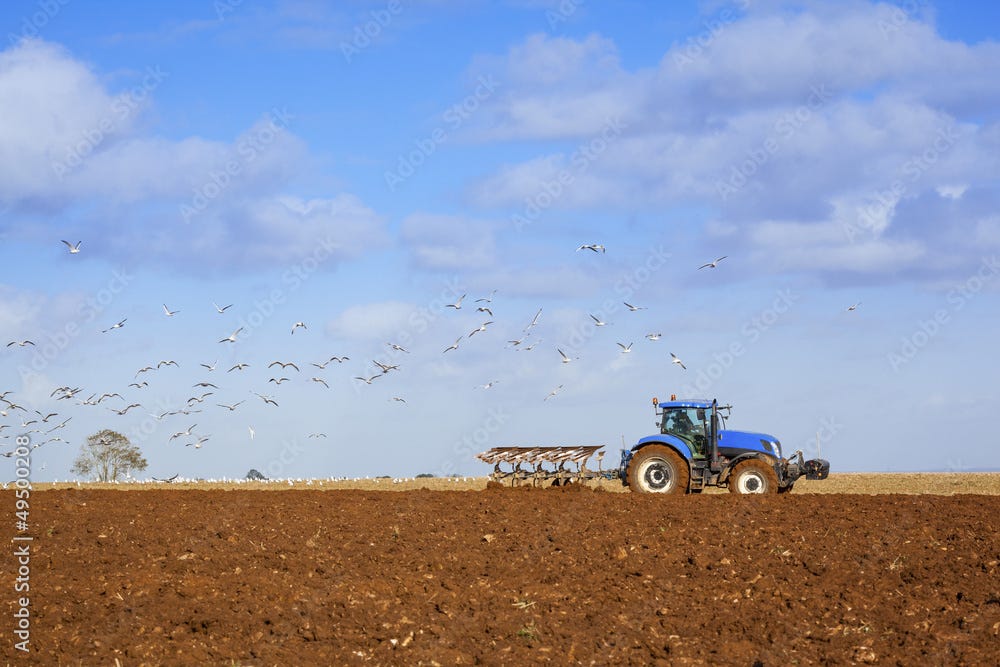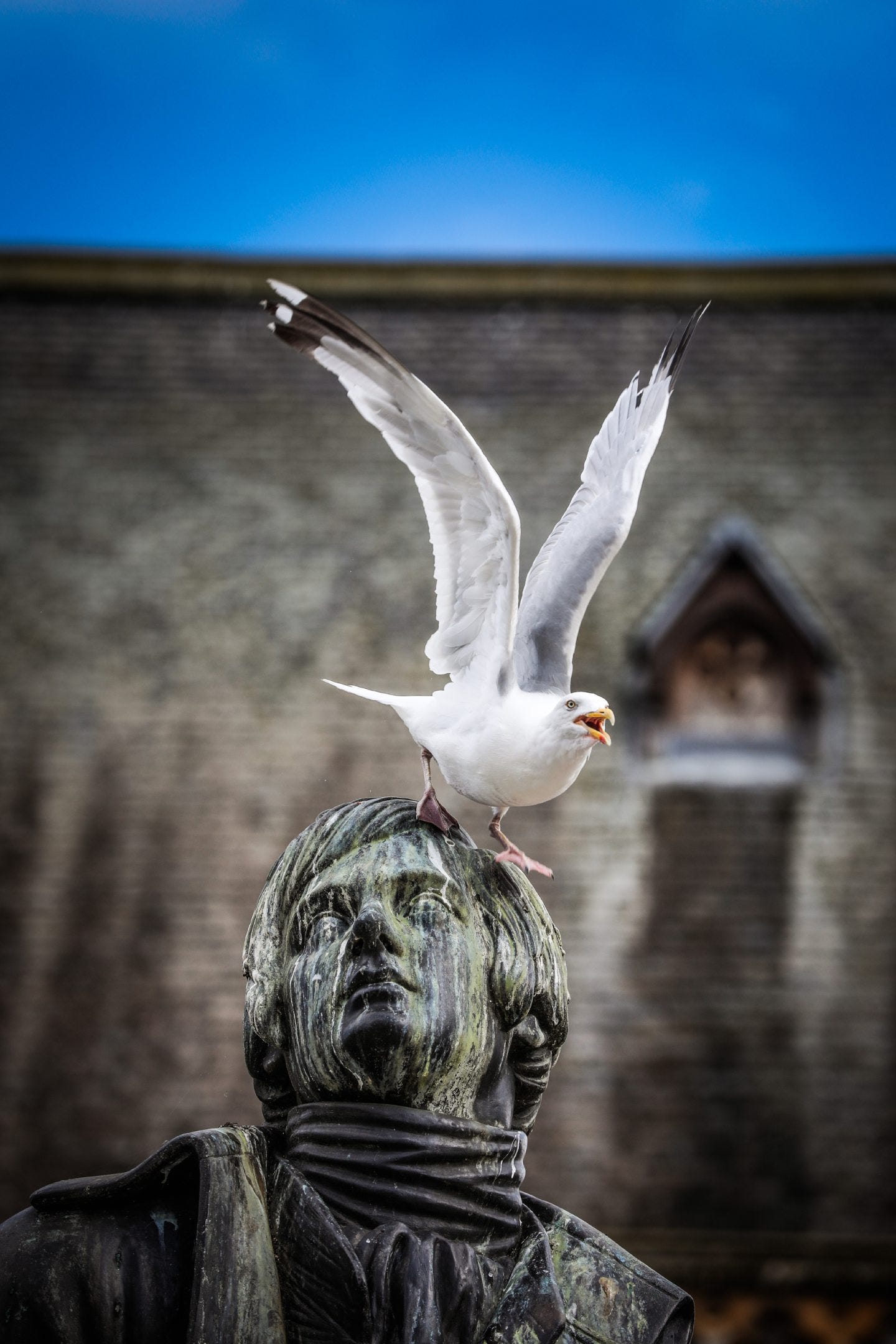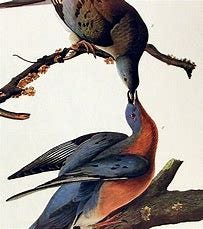Across the road from our house, a tractor is ploughing the field for spring sowing (a job which also seems to demand blindly and indifferently ploughing up the signposted footpath that leads straight across the field towards our nearby town).
Blizzards of gulls are following the tractor, feasting on their findings.
On their five-feet wingspans, herring gulls are gliding in wide circles over our own land, some settling on the roof to survey the prospects. Their ear-rasping two-note screeches summon up beguiling images of yachts riding on their moorings in Cornish harbours or fishing-boats coming home with their catch. Enchanting for an hour or two. Less delightful, perhaps, when they go on all day, every day.
I view these birds ambivalently, recognising their nuisance to others but also having been taught to appreciate them
My mother ended her life in a retirement flat beside the sea in Folkestone. The gulls that congregated in the gardens outside the building were the bane of her last days, especially when the screaming woke her at dawn in the early hours in summer.
A friend of mine is a Fife councillor in a small town by the Firth of Forth. The nuisance of gulls is the single subject that constantly overflows his inbox and for which he is berated by voters every time he goes knocking on doors. “Why don’t you do something?” the people demand of their elected representative. The local media are also constantly on the backs of the council. A recent survey in one of our local papers found that more than half of those asked had a negative view of seabirds in towns. Another survey in 2015 showed that a majority supported culls.
The council has tried everything, including shooting gulls and chicks. They have netted public buildings. They have imported hawks to drive away the seabirds. They have tried dousing eggs in their nests with petrol to keep down the population. Nothing works. The gulls present a persistent and incorrigible problem, with an ingenious determination to continue exploiting their urban feeding grounds.
They nest on roofs from which they scream from sunrise to sunset; they raid bins for scraps; they swoop on people sitting on waterfront benches with bags of chips in their hands; they swarm like bees over landfill sites; they dump their big bombs of excrement all over parked cars and front gardens. In Dundee this year, the Burns Club decided not to advertise its forthcoming Burns Night with a photograph of the poet’s statue in the city centre because the bard’s face was mired under gull droppings. Instead, they used a photograph of a copy of the statue in Christchurch, New Zealand.
Many people, then, view the herring gull through a lens of hatred and resentment. I like to see them more indulgently.
That view was largely formed some time ago during a long conversation on a guided walk with the Scottish Ornithology Club. We were standing near a pile of manure which was besieged by herring gulls, prompting a discussion of the species.
Our leader and guide said, “Live and let live is my motto. Our current attitudes are symptomatic of the disconnect between humans and nature. For instance, drawings and plates of towns on the west coast of Scotland in Burns’s own time clearly show herring gulls nesting on roofs yet nobody was calling for their destruction then.
Herring gulls were once the most populous of gulls but are now so depleted that they are red-listed for conservation concern and are on the verge of becoming an endangered species. Their natural habitats have been under attack for decades. The seas have been fished to death. They are driven to landfill sites and bins in streets in order to survive. Do we actually want the herring gull to be the passenger pigeon of our own day, in our own country?”
Good question, grievous point. I knew nothing about the passenger pigeon until a few years ago when the National Museum of Scotland held an exhibition of Audubon plates from his book The Birds of America. One was of passenger pigeons, the bird which had been the most populous species across North America, with a population greater than all the humans in China and India combined, until Europeans arrived to hunt and shoot it to absolute extinction.
Audubon’s own observations on the abundance of passenger pigeons are worth recalling:
“I dismounted, seated myself on an eminence, and began to mark with my pencil, making a dot for every flock that passed. In a short time finding the task which I had undertaken impracticable, as the birds poured in in countless multitudes, I rose and, counting the dots then put down, found that 163 had been made in twenty-one minutes. I travelled on, and still met more the farther I proceeded. The air was literally filled with Pigeons; the light of noon-day was obscured as by an eclipse; the dung fell in spots, not unlike melting flakes of snow, and the continued buzz of wings had a tendency to lull my senses to repose ... I cannot describe to you the extreme beauty of their aerial evolutions, when a hawk chanced to press upon the rear of the flock. At once, like a torrent, and with a noise like thunder, they rushed into a compact mass, pressing upon each other towards the center. In these almost solid masses, they darted forward in undulating and angular lines, descended and swept close over the earth with inconceivable velocity, mounted perpendicularly so as to resemble a vast column, and, when high, were seen wheeling and twisting within their continued lines, which then resembled the coils of a gigantic serpent ... Before sunset I reached Louisville, distant from Hardensburgh fifty-five miles. The Pigeons were still passing in undiminished numbers and continued to do so for three days in succession.”
In Edinburgh, I stood for a long time in front of his glorious painting of passenger pigeons, floored with sorrow and despair that our own species can be capable of such destruction.
Perhaps the herring gull needs its own Audubon to draw out its beauties. Then we might see it more humanely.





I know the extremes of gulls.
When I lived in Ayr, close to the fish docks, young gulls kept me awake at night crying outside my window, while the adults coated my car with an amalgam of concrete and superglue. Back in the day, I used to love to read Richard Bach’s “Jonathan Livingstone Seagull”, while listening to the Neil Diamond album of that name (both lasted the same length of time) That opened my mind to the idea that gulls don’t just fly for food, they fly for joy. Put in your earplugs and take time to watch…
I was once eating a pub lunch outside (in Liverpool) when a gull decided it was meal for two. Whilst I have never entertained any pretence of heroism it was disappointing to find I was frightened of a bird. There're big up close, let me tell you. Then there's my son's parrot...